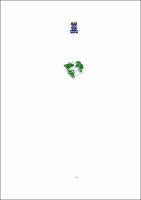| Compartilhamento |


|
Use este identificador para citar ou linkar para este item:
http://tede2.uefs.br:8080/handle/tede/986| Tipo do documento: | Dissertação |
| Título: | Do imaginário ao real: potencial pedagógico da imagem de satélite em ações de educação ambiental ligadas ao Parque Municipal da Serra do Periperi, Vitória da Conquista - BA |
| Autor: | Almeida, Rosângela Sousa de  |
| Primeiro orientador: | Chaves, Joselisa Maria |
| Resumo: | Atualmente os produtos do Sensoriamento Remoto se apresentam como um recurso que possibilita diferentes linguagens para interpretação de dados da superfície terrestre e que atendem às necessidades impostas pela vida cotidiana, nas mais diferentes situações e temas. Com o objetivo de aliar a linguagem da imagem de satélite às ações de Educação Ambiental desenvolvidas numa perspectiva crítica e participativa, esta pesquisa foi realizada tendo como eixo norteador a reflexão acerca da relação estabelecida entre a sociedade, aqui representada por estudantes do 2º Ciclo do Ensino Fundamental (crianças na faixa etária de 08 a 11 anos), da Escola Municipal Zica Pedral, e os recursos naturais integrantes de uma área de proteção localizada no perímetro urbano do município de Vitória da Conquista, interior do estado da Bahia. A metodologia utilizada, inicialmente, aliou elementos da história ambiental, presente em publicações acerca do município, a um exercício de iniciação à leitura cartográfica, a partir da imagem de satélite. Tal procedimento possibilitou o estudo dos conceitos básicos de Sensoriamento Remoto, trabalhados a partir de uma tradução didática da imagem de satélite, cujas reflexões foram sintetizadas em mapas mentais que demonstraram, também, a concepção de ambiente de cada estudante e que contribuíram para a elaboração da estratégia de ação no âmbito da Educação Ambiental. Na segunda etapa, o estudo da percepção ambiental foi realizado por meio da comparação imaginária e real, a partir da imagem de satélite, ou seja, o que a criança imaginava ser o espaço estudado, o que a imagem apresentava e o que, de fato, se viu na realidade, sendo o fruto das reflexões, modelado a partir de dois desenhos síntese. Os resultados alcançados demonstram que a utilização da imagem de satélite como instrumento pedagógico contribui não apenas para reforçar os conceitos referentes à linguagem cartográfica, mas também para estimular, inclusive, o desenvolvimento cognitivo das crianças, pois a partir dela buscou-se o pensamento crítico e reflexivo acerca da relação sociedade e natureza, concretizado por meio da elaboração de hipóteses e projeções acerca do futuro, atividades de fundamental importância para a definição do pensamento com autonomia. |
| Abstract: | Currently the products of remote sensing are presented as a feature that allows different languages to interpret data from surface and that meet the needs imposed by daily life, in different situations and themes. In order to combine the language of the satellite image to the actions of Environmental Education developed a critical perspective and participatory, this research was carried out and are guided by the reflection of the relationship between society, here represented by students from the 2nd cycle of Teaching Elementary (children aged 08-11 years), from the Municipal School Zica Pedral, and natural resources members of a protected area located within the city limits of the city of Vitória, in the state of Bahia. The methodology, initially allied elements of environmental history is present in publications about the council, an exercise in cartographic introduction to reading, from the satellite image. This procedure allowed the study of the basic concepts of Remote Sensing, worked from a translation didactics of satellite imagery, whose reflections were synthesized in mental maps that showed, too, the development environment of each child and contributed to the development of action strategy in the context of Environmental Education. In the second step, the study of environmental perception was done by comparing real and imaginary, from the satellite image, or what the child thought to be the area studied, which had image and that, indeed, if seen in real life is the fruit of reflection, modeled after the synthesis of two drawings. Results show that the use of satellite imagery as an educational tool not only helps to reinforce the concepts related to the cartographic language, but also to stimulate even the cognitive development of children, because as it sought to critical thinking and reflective about the relationship between society and nature, realized from the development of assumptions and projections about the future activities of fundamental importance for the definition of thinking independently. |
| Palavras-chave: | Imagem de satélite Percepção ambiental Unidade de conservação Educação ambiental Satellite image Environmental awareness Conservation area Environmental education |
| Área(s) do CNPq: | CIENCIAS EXATAS E DA TERRA CIENCIAS EXATAS E DA TERRA |
| Idioma: | por |
| País: | Brasil |
| Instituição: | Universidade Estadual de Feira de Santana |
| Sigla da instituição: | UEFS |
| Departamento: | DEPARTAMENTO DE CIÊNCIAS EXATAS |
| Programa: | Mestrado em Modelagem em Ciência da Terra e do Ambiente |
| Citação: | ALMEIDA, Rosangela Sousa de. Do imaginário ao real: potencial pedagógico da imagem de satélite em ações de educação ambiental ligadas ao Parque Municipal da Serra do Periperi, Vitória da Conquista - BA. 2012. 95 f. Dissertação (Mestrado em Modelagem em Ciência da Terra e do Ambiente)- Universidade Estadual de Feira de Santana, Feira de Santana, 2012. |
| Tipo de acesso: | Acesso Aberto |
| URI: | http://tede2.uefs.br:8080/handle/tede/986 |
| Data de defesa: | 27-Mar-2012 |
| Aparece nas coleções: | Coleção UEFS |
Arquivos associados a este item:
| Arquivo | Descrição | Tamanho | Formato | |
|---|---|---|---|---|
| Dissertação final.pdf | Arquivo em texto completo. | 4,76 MB | Adobe PDF |  Baixar/Abrir Pré-Visualizar |
Os itens no repositório estão protegidos por copyright, com todos os direitos reservados, salvo quando é indicado o contrário.




